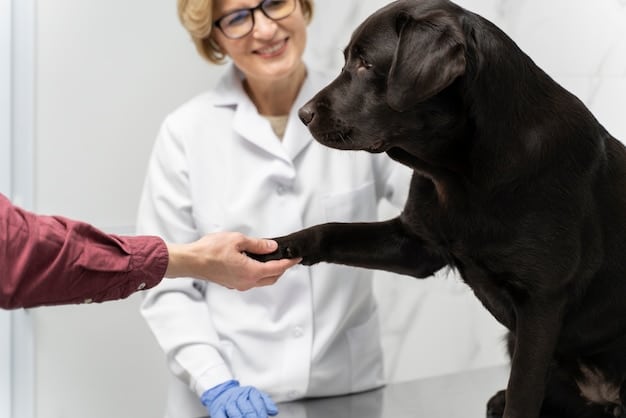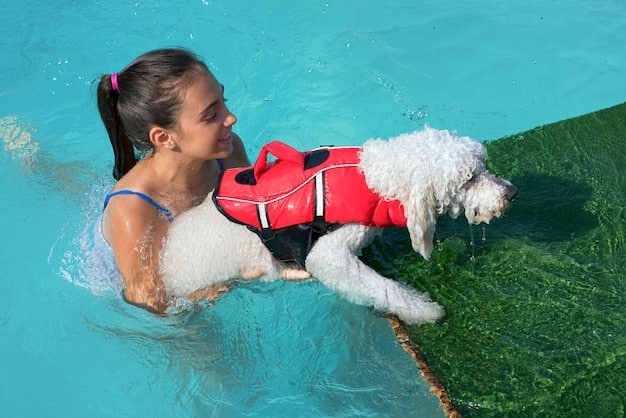Senior Dog Joint Pain Relief: 7 Strategies for Better Mobility

Senior dog joint pain can significantly impact mobility; discover 7 proven strategies, including diet adjustments, exercise, medication, therapies, weight management, and creating a supportive environment, demonstrating how to improve your senior dog’s mobility in 30 days.
Watching your beloved senior dog struggle with joint pain is heartbreaking. The good news is that there are effective strategies you can implement to improve their mobility and quality of life. This article will delve into senior dog joint pain and explore 7 proven strategies to improve mobility in 30 days.
Understanding Senior Dog Joint Pain
Joint pain in senior dogs is a common issue, often stemming from conditions like osteoarthritis or hip dysplasia. Recognizing the signs and understanding the underlying causes is the first step toward providing your furry friend with relief.
Common Causes of Joint Pain
Osteoarthritis, a degenerative joint disease, is the leading cause of joint pain in older dogs. Other causes include hip dysplasia, elbow dysplasia, patellar luxation, and injuries sustained earlier in life. Weight, genetics, and breed can also play a role.
Recognizing the Signs
Spotting the signs of joint pain early can make a significant difference. Common symptoms include stiffness, limping, reluctance to move, difficulty getting up or down, changes in behavior (such as irritability), and licking or chewing at affected joints.

Early detection of senior dog joint pain is key to effective management.
Here are some important things to consider when managing your dog’s joint pain:
- Observe your dog’s gait: Look for any changes in how they walk or run.
- Check for swelling or tenderness: Gently feel your dog’s joints for any signs of inflammation.
- Monitor their activity levels: Note any decrease in their willingness to play or go for walks.
Addressing the factors that contribute to senior dog joint pain is essential for long-term management.
In summary, understanding the causes and recognizing the signs of joint pain in senior dogs are crucial first steps in providing effective care and improving their mobility. By paying close attention to your dog’s behavior and physical condition, you can work with your veterinarian to develop a tailored treatment plan.
Dietary Adjustments for Joint Health
What your senior dog eats plays a vital role in managing joint pain. Certain nutrients and supplements can help reduce inflammation and support joint health.
The Importance of Omega-3 Fatty Acids
Omega-3 fatty acids, particularly EPA and DHA, have potent anti-inflammatory properties. Adding foods rich in Omega-3 fatty acids can help reduce joint inflammation and improve mobility. Fish oil is an excellent source of these beneficial fats.
Supplements to Consider
Glucosamine and chondroitin are popular supplements known for their joint-protecting effects. These compounds help rebuild cartilage and reduce pain. Other supplements such as MSM (methylsulfonylmethane) can also aid in reducing inflammation and supporting joint health.
A balanced diet is crucial in managing senior dog joint pain.
Here are some things to keep in mind when choosing your dog’s diet:
- Look for high-quality protein sources: Protein is essential for maintaining muscle mass, which supports joint stability.
- Ensure adequate hydration: Proper hydration helps keep joint tissues lubricated.
- Consult your veterinarian: They can recommend a diet tailored to your dog’s specific needs and health condition.
Proper nutrition can significantly alleviate senior dog joint pain.
Choosing the right diet and supplements can significantly alleviate joint pain and improve your senior dog’s mobility. Always consult with your veterinarian before making significant changes to your dog’s diet or introducing new supplements to ensure they are safe and appropriate for their individual needs.
The Role of Exercise in Maintaining Mobility
While it may seem counterintuitive, regular exercise is essential for maintaining mobility in senior dogs with joint pain. However, it’s crucial to choose low-impact activities that won’t exacerbate their condition.
Low-Impact Exercises
Walking, swimming, and gentle stretching are excellent low-impact exercises that can help keep your senior dog’s joints lubricated and maintain muscle strength. Short, frequent walks are often better than long, strenuous hikes.
Hydrotherapy
Hydrotherapy, such as swimming or underwater treadmill sessions, is a fantastic option for dogs with joint pain. The buoyancy of water reduces stress on the joints, allowing them to exercise with less pain.

Regular, controlled exercise helps manage senior dog joint pain.
Consider these recommendations for exercising your dog:
- Start slowly: Gradually increase the duration and intensity of exercise.
- Monitor their comfort level: Watch for signs of pain or fatigue, and adjust the activity accordingly.
- Incorporate rest periods: Ensure they have ample time to recover between exercise sessions.
Appropriate physical activity can greatly minimize senior dog joint pain.
Regular, controlled exercise is essential for maintaining mobility and minimizing joint pain in senior dogs. By choosing low-impact activities and closely monitoring your dog’s comfort level, you can help them stay active and enjoy a better quality of life.
Medication and Pain Management
When lifestyle adjustments aren’t enough, medication can play a crucial role in managing joint pain in senior dogs. Several options are available, and your veterinarian can help you determine the best course of action.
NSAIDs (Non-Steroidal Anti-Inflammatory Drugs)
NSAIDs are commonly prescribed to reduce pain and inflammation in dogs with osteoarthritis. These medications can provide significant relief, but they can also have potential side effects, so it’s essential to use them under veterinary supervision.
Other Pain Relief Options
Other pain relief options include tramadol, gabapentin, and amantadine. These medications work through different mechanisms and may be used alone or in combination with NSAIDs. In some cases, corticosteroids may be prescribed for short-term relief, but they are not ideal for long-term use due to potential side effects.
With medical management, you can reduce senior dog joint pain.
Things to remember with medications:
- Always follow your veterinarian’s instructions: Do not adjust the dosage without consulting them.
- Monitor for side effects: Watch for signs such as vomiting, diarrhea, or loss of appetite.
- Regular veterinary check-ups: Periodic evaluations are necessary to assess the medication’s effectiveness and monitor for any adverse effects.
Proper medication can significantly minimize senior dog joint pain.
Medication can be a valuable tool in managing joint pain in senior dogs. By working closely with your veterinarian, you can find the right medication and dosage to provide your furry friend with the relief they need while minimizing the risk of side effects.
Therapies and Rehabilitation
In addition to medication, various therapies and rehabilitation techniques can help improve mobility and reduce pain in senior dogs with joint issues.
Physical Therapy
Physical therapy involves a range of techniques such as massage, stretching, and therapeutic exercises. A qualified canine physical therapist can develop a customized plan to improve your dog’s strength, flexibility, and range of motion.
Acupuncture
Acupuncture, an ancient Chinese medicine technique, is another beneficial therapy for managing joint pain. Acupuncture involves inserting thin needles into specific points on the body to stimulate the release of endorphins, which can help reduce pain and inflammation. Many pet owners have reported positive results with acupuncture.
Therapy and rehabilitation can greatly minimize senior dog joint pain.
The top points to remember are:
- Find a qualified professional: Ensure the therapist or acupuncturist is experienced and certified in canine rehabilitation.
- Follow their recommendations: Stick to the prescribed exercises and treatment schedule.
- Be patient: It may take time to see significant improvement, so stay consistent with the therapy.
Rehabilitation programs can greatly minimize senior dog joint pain.
Therapies and rehabilitation techniques can provide significant benefits for senior dogs with joint pain. By seeking out qualified professionals and consistently following their recommendations, you can help your dog regain mobility, reduce pain, and enjoy a better quality of life.
Weight Management for Joint Relief
Maintaining a healthy weight is crucial for managing joint pain in senior dogs. Excess weight puts additional stress on the joints, exacerbating pain and reducing mobility. Achieving and maintaining an ideal body weight can significantly alleviate these issues.
Assessing Your Dog’s Weight
Work with your veterinarian to determine your dog’s ideal body weight. They can assess your dog’s body condition score (BCS) and provide guidance on the appropriate weight range for their breed and size. Regular weigh-ins can help you track progress and make necessary adjustments to their diet and exercise routine.
Strategies for Weight Loss
If your senior dog is overweight, gradual weight loss is the key. This can be achieved through a combination of dietary changes and increased physical activity. Feed your dog a high-quality, portion-controlled diet, and avoid giving them excessive treats or table scraps. Incorporate regular exercise into their routine, such as short walks or gentle play sessions.
Proper weight management helps lessen senior dog joint pain.
Important reminders to remember for weight management:
- Measure food portions: Use a measuring cup to ensure you’re feeding the correct amount.
- Choose healthy treats: Opt for low-calorie treats like carrot slices or green beans.
- Increase activity gradually: Start with short, gentle walks and gradually increase the duration and intensity as your dog becomes more comfortable.
Maintaining a healthy weight can greatly minimize senior dog joint pain.
Weight management is a critical component of managing joint pain in senior dogs. By assessing your dog’s weight, implementing strategies for weight loss if needed, and consistently monitoring their progress, you can help them maintain a healthy weight and reduce the stress on their joints.
Creating a Supportive Environment
Making simple changes to your home environment can significantly improve the comfort and mobility of your senior dog with joint pain.
Comfortable Bedding
Provide your dog with a comfortable, orthopedic bed that offers ample support for their joints. Memory foam beds are an excellent choice as they contour to the body and distribute weight evenly, relieving pressure points.
Ramps and Steps
Install ramps or steps to help your dog access furniture, beds, and cars. This can reduce the strain on their joints and make it easier for them to move around.
Creating a supportive environment helps lessen senior dog joint pain.
Here are some key points to maintaining that environment.
- Non-slip flooring: Use rugs or mats to provide traction on slippery floors.
- Elevated food and water bowls: Raising the bowls can reduce strain on the neck and joints when eating and drinking.
- Maintain a comfortable temperature: Ensure your home is warm and draft-free, as cold temperatures can exacerbate joint pain.
A comfortable environment can greatly minimize senior dog joint pain.
Creating a supportive environment is a simple yet effective way to improve the comfort and mobility of your senior dog with joint pain. By providing comfortable bedding, ramps, and steps, and making other small adjustments to your home, you can help your dog move around with greater ease and enjoy a better quality of life.
| Key Point | Brief Description |
|---|---|
| 🦴 Diet Adjustments | Incorporate omega-3s, glucosamine, and chondroitin for joint health. |
| 🚶♀️ Low-Impact Exercise | Walking, swimming, and hydrotherapy for joint lubrication and muscle strength. |
| 💊 Medication | NSAIDs and other pain relief options under vet supervision. |
| 🏡 Supportive Environment | Orthopedic beds, ramps, and non-slip flooring for comfort and ease of movement. |
Frequently Asked Questions (FAQ)
▼
Early signs include stiffness, limping, reluctance to move, and difficulty getting up or down. Changes in behavior, such as irritability, can also indicate pain.
▼
Omega-3 fatty acids and supplements like glucosamine and chondroitin can reduce inflammation and support joint health. Ensure a balanced diet with high-quality protein.
▼
Low-impact exercises like walking, swimming, and gentle stretching are ideal. Hydrotherapy can also be beneficial, as it reduces stress on the joints.
▼
NSAIDs (Non-Steroidal Anti-Inflammatory Drugs) are commonly prescribed to reduce pain and inflammation. Other options include tramadol, gabapentin, and amantadine.
▼
Provide a comfortable, orthopedic bed, install ramps or steps, use rugs or mats for traction, and ensure a warm and draft-free environment.
Conclusion
Managing senior dog joint pain requires a comprehensive approach involving dietary adjustments, appropriate exercise, medication, therapies, and environmental modifications. By implementing these strategies, you can significantly improve your senior dog’s mobility and enhance their overall quality of life. Always consult with your veterinarian to develop a personalized plan that meets your dog’s unique needs.





